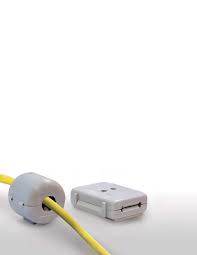
The Use Of Ferrite To Suppress EMI Issues
An increasing level of electromagnetic interference (EMI) emissions has necessitated the introduction of stricter electromagnetic compatibility (EMC) regulation s worldwide. The first step to avoid interference problems is to incorporate EMI-suppression components right at the beginning of the design phase. Ferrites, which are magnetic oxide material with great electrical and magnetic properties, offer a solution to many problems relating to electromagnetic or radio frequency interferences (RFI). They can be used in multiple ways. For example, cable assemblies made of ferrites are used internally or externally to suppress common EMI problems in electronic equipment. By helping to reduce the levels of EMI radiation internally, ferrites help to confine EMI within a product’s enclosure, subsequently helping to cut down the shielding cost significantly. Alternatively, products such as cable snap ferrites and ferrite beads are used externally to tackle EMI. These are functional with wires and cables.

Physical Properties of Ferrites
Being a type of insulated magnetic oxide, ferrite possesses high electrical resistivity, low eddy current and dielectric losses, high permeability and moderate permittivity.
Ferrite Types
Ferrite can be classified into three different types:
-
Hexagonal ferrite
-
Spinel ferrite
-
Garnet
Spinel ferrite is the most widely -used variety of ferrite It is characterized by the presence of a high degree of electrical resistivity and low eddy current losses. These physical properties make them ideal for their use in television scanning.
Hexagonal ferrites are the type of oxides in which oxygen ions are closely-packed in a hexagonal crystal structure. Characterized by high coercivity, they are widely used as permanent magnets at very high frequency.
Garnet ferrites have complex crystal structure. They have major technological importance due to their applications in computer memory structure.
How Do Ferrite Material Types Work
To achieve the maximum EMI shielding performance in a particular application, you have to select your ferrite material wisely. It should have an inner diameter that closely matches the outer diameter of the wire to be shielded. In order to increase the in-circuit impedance, two turns of the wire conductor are run through the ferrite core. In most of the applications, typically two conductors are used. This arrangement facilitates a flow of equal and opposite currents through the core, leading to the establishment of zero net bias and maximum impedance.
Ferrite Applications
Thanks to its unique physical properties, ferrites find a wide-ranging application in almost all fields. They are used in transformer cores, antenna rods, memory chips, high-density magnetic recording media, permanent magnets, transducers, activators, microwave, and computers. They are shifted on wire as beads and tubes, and mounted on PCB, multilayer suppressors or integrated inductive components. Molded into a connector, ferrites are used as ring cores or U cores in mains filters. They are mostly used as wideband chokes or coiled rod inductors in electrical appliances or motors. Ferrite materials are also used on power cables that carry digital or analog signaling.
Nanocrystalline ferrite materials find their applications in a host of emerging fields such as magnetic resonance imaging (MRI), magnetically guided drug delivery, humidity and gas sensors, magnetic fluids and a few more.
Just like iron, cobalt and nickel, ferrites possess spontaneous magnetic moment below the Curie temperature. This helps increase their importance in the fields of engineering and technology.
Their low eddy current losses make them fit for use as a core of coils in microwave frequency devices and computer memory chips.
Blame it on their relatively low permeability and flux density, ferrites are not suitable for use in high field and high power applications, such as motors, generators and power transformers. However, they are perfectly suitable for use in low field and low power applications.
Besides being used as ferromagnetic insulators in electrical circuits, ferrites are also used as switches in different electronic equipment including refrigerators and air conditioners. They are also used as magnetic head transducer in recording. The ZnO version of ferrites are used in low frequency applications like timers.
Various kinds of applications use ferrite cables to deal with EMI issues. The use of the right ferrite product is however crucial for ensuring the successful suppression of EMI. Product designers should therefore choose the vendors wisely while procuring any ferrite material.




